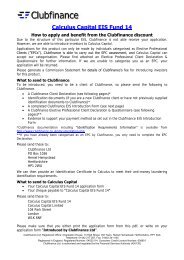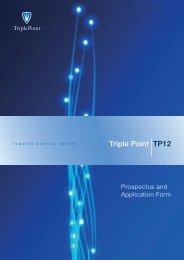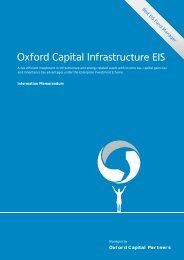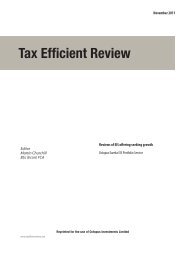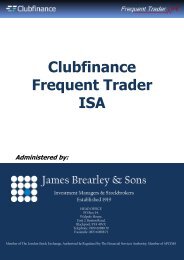OAM2681 OVCT 2 Prospectus aw12 - Clubfinance
OAM2681 OVCT 2 Prospectus aw12 - Clubfinance
OAM2681 OVCT 2 Prospectus aw12 - Clubfinance
You also want an ePaper? Increase the reach of your titles
YUMPU automatically turns print PDFs into web optimized ePapers that Google loves.
PART NINE – CONDITIONS TO BE MET<br />
BY VENTURE CAPITAL TRUSTS<br />
The Company has to satisfy a number of tests to qualify as a VCT. A<br />
summary of these tests is set out below.<br />
1. Qualification as a VCT<br />
To qualify as a VCT, a company must be approved as such by<br />
HMRC. To obtain such approval it must:<br />
(a)<br />
(b)<br />
(c)<br />
(d)<br />
(e)<br />
(f)<br />
(g)<br />
not be a close company;<br />
have each class of its ordinary share capital quoted on the<br />
London Stock Exchange;<br />
derive its income wholly or mainly from shares or<br />
securities;<br />
have at least 70% by VCT Value of its investments in<br />
shares or securities in Qualifying Investments, of which<br />
30% by VCT Value must be in eligible shares;<br />
have at least 10% by VCT Value of each Qualifying<br />
Investment in eligible shares;<br />
not have more than 15% by VCT Value of its investments<br />
in a single company or group (other than a VCT or a<br />
company which would, if its shares were listed, qualify as a<br />
VCT); and<br />
not retain more than 15% of its income derived from<br />
shares and securities in any accounting period.<br />
The requirement set out in paragraph (d) above will be<br />
amended for funds raised from 6 April 2011, such that at least<br />
70% by VCT Value of a VCT’s investments in shares or securities<br />
in qualifying investments must be in eligible shares which carry no<br />
preferential rights and no rights to be redeemed. For funds raised<br />
from 6 April 2011, ‘eligible shares’ means shares which do not<br />
carry any rights to be redeemed or a preferential right to assets<br />
on a winding-up or dividends (in respect of the latter, where the<br />
right to the dividend is cumulative or, where the amount or<br />
dates of payment of the dividend may be varied by the company,<br />
a shareholder or any other person.<br />
2. Qualifying Investments<br />
A Qualifying Investment consists of shares or securities first<br />
issued to the VCT (and held by it ever since) by a company<br />
satisfying the conditions set out in Chapters 3 and 4 of Part 6 of<br />
ITA 2007 and for which not more than £1 million was<br />
subscribed in any one tax year (nor more than £1 million in any<br />
period of six months straddling two tax years).<br />
The conditions are detailed but include that the company must<br />
be a Qualifying Company, have gross assets not exceeding £7<br />
million immediately before and £8 million immediately after the<br />
investment, apply the money raised for the purposes of a<br />
qualifying trade within certain time periods and not be<br />
controlled by another company. In certain circumstances, an<br />
investment in a company by a VCT can be split into a part<br />
which is a qualifying holding and a part which is a non-qualifying<br />
holding. In addition, to be qualifying holdings, VCTs must invest<br />
in companies which have fewer than 50 full-time (equivalent)<br />
employees and do not obtain more than £2 million of<br />
investment from VCTs and individuals claiming relief under the<br />
Enterprise Investment Scheme in any rolling 12 month period.<br />
3. Qualifying Companies<br />
A Qualifying Company must be unquoted (for VCT purposes<br />
this includes companies whose shares are traded on PLUS and<br />
AIM) and must carry on a qualifying trade. For this purpose<br />
certain activities are excluded (such as dealing in land or shares<br />
or providing financial services). The qualifying trade must either<br />
be carried on by, or be intended to be carried on by, the<br />
Qualifying Company or by a qualifying subsidiary at the time of<br />
the issue of shares or securities to the VCT (and at all times<br />
thereafter). The company’s trade must be, carried on wholly or<br />
mainly in the UK (such requirement to be amended to the<br />
company having a permanent establishment in the UK from 6<br />
April 2011), but the company need not be UK resident. A<br />
company intending to carry on a qualifying trade must begin to<br />
trade within two years of the issue of shares or securities to the<br />
VCT and continue it thereafter.<br />
A Qualifying Company may have no subsidiaries other than<br />
qualifying subsidiaries which must, in most cases, be at least<br />
51% owned.<br />
4. Approval as a VCT<br />
A VCT must be approved at all times by HMRC. Approval has<br />
effect from the time specified in the approval.<br />
A VCT cannot be approved unless the tests detailed above are<br />
met throughout the most recent complete accounting period of<br />
the VCT and HMRC is satisfied that they will be met in relation<br />
to the accounting period of the VCT which is current when the<br />
application is made. However, where a VCT raises further funds,<br />
VCTs are given grace periods to invest those funds before such<br />
further funds become subject to the tests.<br />
However, to aid the launch of a VCT, HMRC may give<br />
provisional approval if satisfied that conditions (b), (c), (f) and<br />
(g) in paragraph 1 above will be met throughout the current or<br />
subsequent accounting period and condition (d) in paragraph 1<br />
above will be met in relation to an accounting period<br />
commencing no later than three years after the date of<br />
provisional approval.<br />
The Company has obtained provisional approval as a VCT<br />
from HMRC.<br />
5. Withdrawal of approval<br />
Approval of a VCT (full or provisional) may be withdrawn by<br />
HMRC if the various tests set out above are not satisfied. The<br />
exemption from corporation tax on capital gains will not apply<br />
to any gain realised after the point at which VCT status is lost.<br />
Withdrawal of approval generally has effect from the time when<br />
notice is given to the VCT but, in relation to capital gains of the<br />
VCT only, can be backdated to not earlier than the first day<br />
of the accounting period commencing immediately after the<br />
last accounting period of the VCT in which all of the tests<br />
were satisfied.<br />
Withdrawal of provisional approval has effect as if provisional<br />
approval had never been given (including the requirement to<br />
pay corporation tax on prior gains).<br />
The above is only a summary of the conditions to be satisfied for a<br />
company to be treated as a VCT.<br />
22






